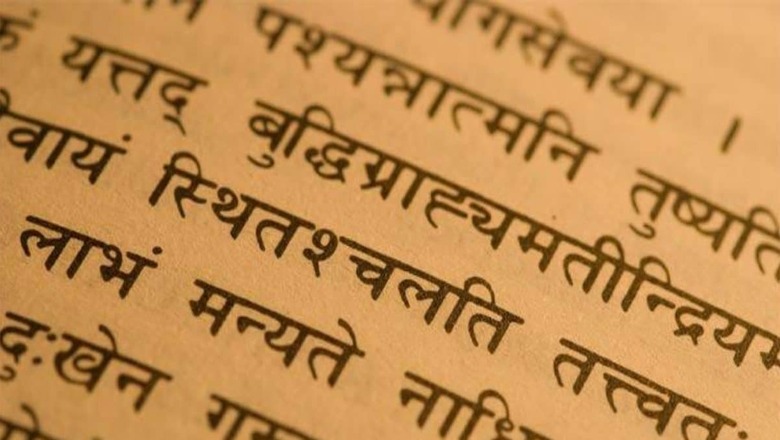
views
This Raksha Bandhan (August 19) marks the 56th National Sanskrit Day. The Sansadiya Sanskrit Parishad (Association of Members of Parliament for the Propagation and Development of Sanskrit), founded by Dr Karan Singh in 1967, recommended the observance of this day on Shravani Purnima. The centrepiece of the first Sanskrit Day, celebrated across the country on August 27, 1969, was a two-day convention of Vedic recitation in New Delhi. The event was inaugurated by Prof. K.V.R.V. Rao, the then Union Minister of Education and Youth Services. National Sanskrit Day has been observed annually on Raksha Bandhan since then.
The first recognisable step taken by the Indian government for the preservation and development of Sanskrit was the setting up of an eight-member Sanskrit Commission on October 1, 1956, under the chairmanship of eminent linguist and author Dr Suniti Kumar Chatterjee. This was admittedly not the first committee/commission to inquire into the condition of Sanskrit in India. The Report of the Sanskrit Commission (1956-57) itself lists around 11 such committees established by various provinces/states between 1938 and 1955. However, the terms of reference (ToR) of the Commission reveal that the ambit of Sanskrit was confined only to academics-
- To undertake a survey of the existing facilities for Sanskrit education in universities and non-university institutions and to make proposals for promoting the study of Sanskrit, including research.
- To examine the traditional system of Sanskrit education to determine which aspects could be beneficially incorporated into the modern system.
Sanskrit’s coeval status with pedagogy reflects the diminished role of the language in the modern era. There is no presence of Sanskrit in journalism, modern literature, the film and music industries, advertising, or public relations. Most accomplished Sanskrit scholars aspire to secure teaching positions, so when they speak of the ‘promotion of Sanskrit,’ they primarily refer to the creation of more teaching posts.
The Sanskrit Commission independently explored the preservation and research of Sanskrit manuscripts, another area of interest for Sanskrit scholars. While Sanskrit undeniably holds a great heritage, it is more about the past than the future.
It might seem that Sanskrit, once the standard language of literary, scientific, religious, and philosophical pursuits in ancient India, has now come to occupy just a niche in modern times. Sanskrit is indeed taught in India from secondary school to the post-doctoral level, and classes are often oversubscribed. Yet, its impact is scarcely felt outside the academic sphere.
In ancient India, Sanskrit was the vehicle of knowledge production and the medium of exchange among scholars. The breadth of Sanskrit literature was astounding, reflecting the richness of ancient Hindu civilisation. It would be an understatement to think that Sanskrit only dealt with profound subjects like religion, spirituality, philosophy, music, astronomy, astrology, medicine, architecture, and polity. There was also a lighter side to Sanskrit, such as Prahasana (or farce), a form of drama that made spectators laugh and giggle. Plays like Mṛcchakaṭika by Raja Shudraka prove that Sanskrit literature was deeply connected to the everyday lives of ancient Indians. When this connection waned, Sanskrit became confined to sacred alcoves.
The decline in Sanskrit’s dominance began towards the start of the second millennium. This columnist identifies Sant Jnandeva (1275–1296), the spiritual prodigy from Maharashtra, as a figure symbolising the decline of Sanskrit and the rise of vernacular languages in the literary sphere. Earlier, Gautama Buddha (circa 6th century) had disregarded Sanskrit (which he called “Chhandaso“) and advocated for the use of local languages. However, Buddhist monks later fully adopted Sanskrit during the Mahayana period (all the works of the Nalanda tradition were written in this refined language), marking the eventual failure of Buddha’s linguistic experiment in the long run.
Until the 12th century, Sanskrit held sway, as exemplified by the poet Jayadev, who composed the Gita Govinda in that classical language. Had he written the work in his mother tongue, the debate over whether Jayadev was Bengali or Odia might have been easily resolved. However, a century later, when Jnandeva composed 9,000 stanzas of exquisite poetry in the Jnaneswari, an exposition of the Bhagavad Gita, he chose Marathi, not Sanskrit, despite being well-versed in that revered language. His Amrutanubhav and abhangs (psalms) to Lord Vitthal were also written in Marathi. Jnandeva thus initiated a revolution by ‘liberating’ (if one might call it that) Hindu literature from Sanskrit, making it accessible to the common people. Although he was a non-dualist by conviction, like Adi Shankaracharya, he took a radically different approach when it came to language.
II
Sanskrit came under intense stress during the medieval era with the advent of Muslim rule. The destruction of the vast library at Nalanda Mahavihara has become legendary. Historian Ashirbadi Lal Srivastava (1964) notes that after Al-Beruni, no outstanding Muslim figure was associated with Sanskrit learning. While a few Sultans, such as Firoz Shah Tughlaq and Sikandar Lodi, ordered the translation of some Sanskrit works into Persian, it is mistakenly believed that this constituted patronage of Sanskrit literature and its scholars. The translated works were primarily of practical interest, and there is no evidence of any Sanskrit scholar being present at the court of any Sultan of Delhi (The Sultanate of Delhi, pp. 329-330).
Although the medieval era was not devoid of Sanskrit composition in fields such as Hindu law, astronomy, logic, and philosophy, the dominance of this classical language was challenged by local languages, particularly in the realm of literature. Kabir and Goswami Tulsidas, despite holding diametrically opposite views on organised religion and coming from different ends of the caste hierarchy, were united by their creation of works of high literary value in local dialects that resonated widely with the masses. Although they lived in different epochs, both resided in Varanasi, a significant centre of Sanskrit learning. While Kabir, who was unlettered, composed verses orally, Tulsidas, well-versed in Sanskrit, chose to write in Awadhi. The social mobilisation they achieved through their works in local dialects was unparalleled.
With a new Muslim royalty and aristocracy of foreign origin entrenched in India, Persian became the language of law, revenue, administration, and the military. The medieval era witnessed a surge in literary production in local dialects and vernaculars across India. Much of this material was devotional in nature. Tulsidas composed his Ramcharitmanas in Awadhi, defying orthodox pundits who claimed that the Ramayana could not be rendered in any non-Sanskrit language. Tulsidas, a Brahmin by birth, effectively staged a coup against his own class. His intuition in preferring the vernacular over Sanskrit was validated by the enduring popularity of his text. His command over Sanskrit is evident from the invocations at the beginning of every Canto (Kanda) of the Ramcharitmanas.
This pattern, where poets well-versed in Sanskrit chose to write in the vernacular during the medieval ages, demonstrated a clear connection with the masses. However, vernacular languages were not trusted for legal, scientific, or philosophical works. Sawai Jai Singh (1688-1743), the ruler of Amber, had several works translated from Arabic, Persian, and English into Sanskrit. With the benefit of hindsight, these translations might have been far more useful if rendered in Rajasthani or Hindi. Jai Singh’s interpreter, Muhammed Abid, and translator, Nayansukh, were both well-versed in astronomy. According to Sriramalu Rajeswara Sarma, they needed only to cross the linguistic barrier and work with a third language, which must have been some form of Hindi (Translation of Scientific Texts into Sanskrit under Sawai Jai Singh, S.V.U. Oriental Journal, Vol. XLI, 1998, p. 78). More than a century later, Pathani Samanta (1835-1904) wrote his treatise on astronomy, Siddhanta Darpana (1899), in Sanskrit using the Odia script. The book was fully translated into English exactly a century later by Arun Upadhyaya, IPS.
As a result, Siddhanta Darpana failed to influence the broader discourse, unlike Bal Gangadhar Tilak’s books The Orion: Or Researches into Antiquity of the Vedas and The Arctic Home in the Vedas, written during the same decade. Tilak, well-versed in Sanskrit, chose English to write both books.
III
The advent of British rule landed Sanskrit in an ambiguous situation. In pursuit of the policy of “orientalism”, initiated by Warren Hastings, the British set up two Sanskrit colleges in India – Central Sanskrit College (estd.1791), in Benaras, now incorporated in Sampurnanad Sanskrit Vishwavidyalaya, Varanasi (brief history) and Sanskrit College (estd.1824) in Calcutta (see history). The Asiatic Society (estd.1784) and now extinct Fort William College (1800-54) played an excellent role in the discovery of Sanskrit manuscripts, their translation and publications.
For the first time, the ancient language got the benefit of printing technology, introduced by the British in the 1770s in India, leading to the conversion of the traditional format of Sanskrit texts from horizontal unbound pothis to modern hardbound/paperback editions of codex books.
The new challenge to Sanskrit was not active persecution, or even neglect (instead there was actually a promotion), but diffusion of the new knowledge in India through English. The knowledge system of Sanskrit was found caught in a time-warp (for instance as late as 1899, Pathani Samanta, though an excellent naked-eye observational astronomer, believed in a geocentric model of the universe).
There was a significant demand for English education in contemporary Indian society, particularly among Hindus as opposed to Muslims. This was primarily because all the latest, practical, and scientific knowledge was available in English. Hindu College (established in 1817) in Calcutta (now Kolkata) and Elphinstone College (established in 1834) in Bombay (now Mumbai) were set up on the initiative of Hindu society. Thus, the nationalist allegation that Lord Macaulay “imposed” English on India with ulterior motives is fallacious. Hindu society gained an advantage over Muslims in new professions such as medicine, law, engineering, and government service through proficiency in English. Muslim leaders like Syed Ameer Ali (1882) lamented how Hindus were advantageously placed in government departments in Bengal, Bihar, and Orissa (Odisha), a reversal of fortunes in less than a century.
Sanskrit departments were part of all universities set up by the British between 1857 (Calcutta, Bombay, and Madras) and 1927 (Dhaka University), refuting the allegation of discrimination against that language. This is further proven by the fact that it was under colonial authority that Swami Shraddhanand of Arya Samaj could set up Gurukul Kangri (established in 1902) and Pt. Madan Mohan Malaviya could establish Banaras Hindu University (BHU) (established in 1916). Pt. Malaviya aimed to develop BHU as a centre of excellence for Vedic/Sanskrit studies as well as modern education. The establishment of BHU enjoyed the support of the British government, to the extent that Lord Hardinge of Penhurst, the Viceroy of India, laid its foundation stone on February 4, 1916, coinciding with Vasant Panchami.
This, however, illustrates the central position Sanskrit has taken, becoming coeval with pedagogy in modern times. For instance, when Swami Shraddhanand or Pt. Malaviya had to deliver lectures or write tracts, they naturally used English, not Sanskrit.
Shraddhanand’s predecessor and the founder of Arya Samaj, Swami Dayanand Saraswati (1824-1883), actually used Sanskrit for both philosophical disputation and delivering discourses. Hailing from Gujarat, he apparently knew little Hindi, despite residing in northern India for an extended period. According to his biographer J.T.F. Jordens (1978), during a private conversation with Brahmo Samaj’s Keshub Chandra Sen in Calcutta in 1873, Dayanand accepted Sen’s suggestion to use Hindi instead of Sanskrit to reach the masses. Dayanand began using a little Hindi in his speech at Kanpur (November 1873) and significantly more in Benaras (May-June 1874). This reportedly changed the composition of his meetings, with more common people and fewer pundits attending his lectures thereafter (Dayānanda Sarasvatī: His Life and Ideas, pp. 82-83).
Dayanand wrote his Satyarth-Prakash (1875) in Hindi, indicating how rapidly he mastered the language since 1873. He thus became the latest entrant in the league of Sant Jnandev and Goswami Tulsidas in taking the message of Hindu religion to the masses. Throughout the British period, the modern Indian languages (MILs) experienced unprecedented progress. Novels, short stories, essays, and travelogues were new literary formats that enriched Indian languages. The advent of journalism and the book trade popularised these languages. However, Sanskrit failed to take advantage of these new circumstances. Even without the patronage of any Vikramaditya, the modern Indian languages produced their Bankim Chandra, Tagore, Bharathendu Harishchandra, Jayshankar Prasad, Nirala, and Subramania Bharati.
Why Sanskrit failed to produce its new Kalidas, Bharavi, and Bhavabhuti requires introspection on the part of its proponents. Sanskrit had flourished and produced its finest gems when there was no competition for its dominance, much like Doordarshan in our times. However, once competition arose, the language failed to keep pace with the changing grammar of time.
Sanskrit will still remain a repository of Hindu religion and Indian culture. However, its halcyon days are behind us.
The writer is author of the book ‘The Microphone Men: How Orators Created a Modern India’ (2019) and an independent researcher based in New Delhi. Views expressed in the above piece are personal and solely those of the author. They do not necessarily reflect News18’s views.

















Comments
0 comment